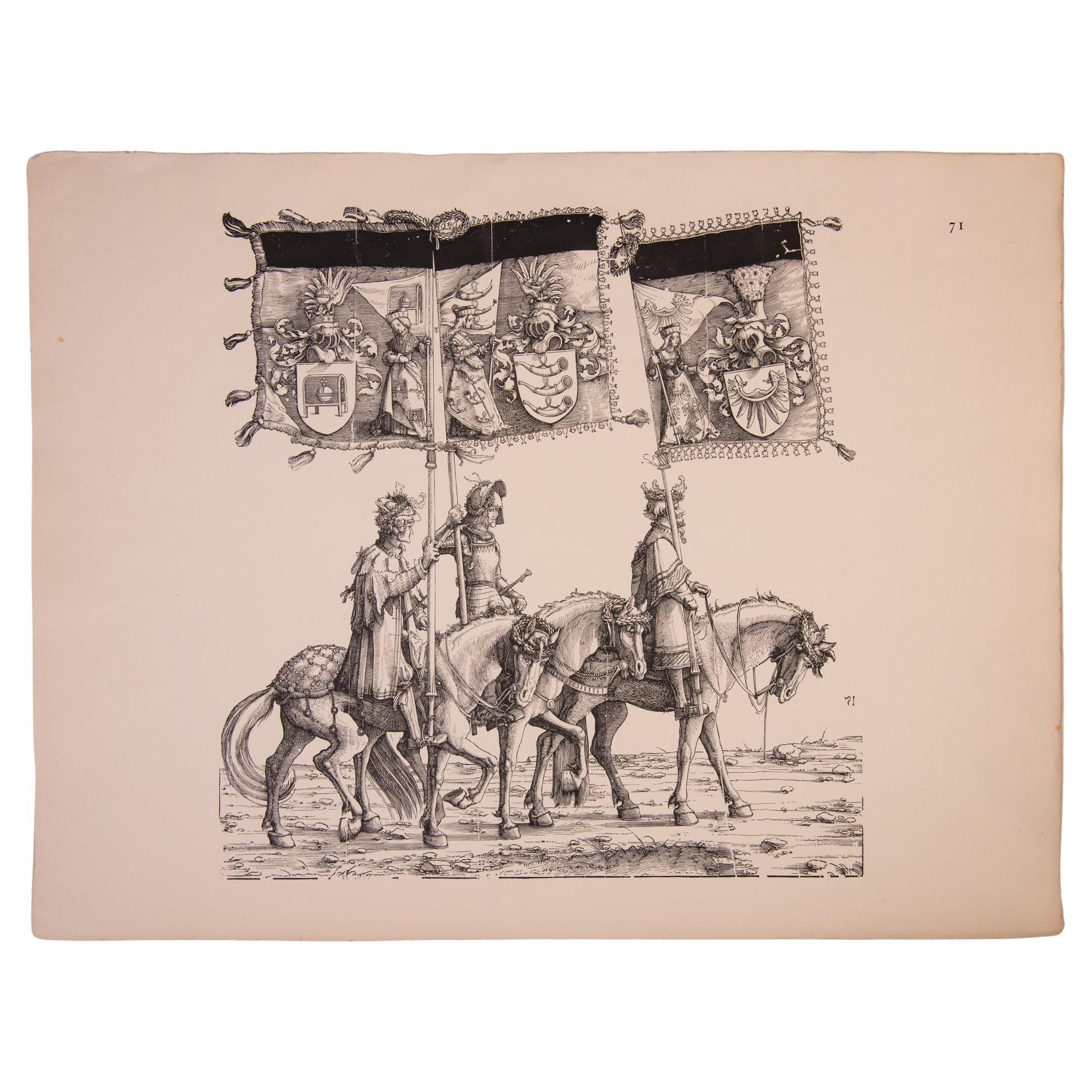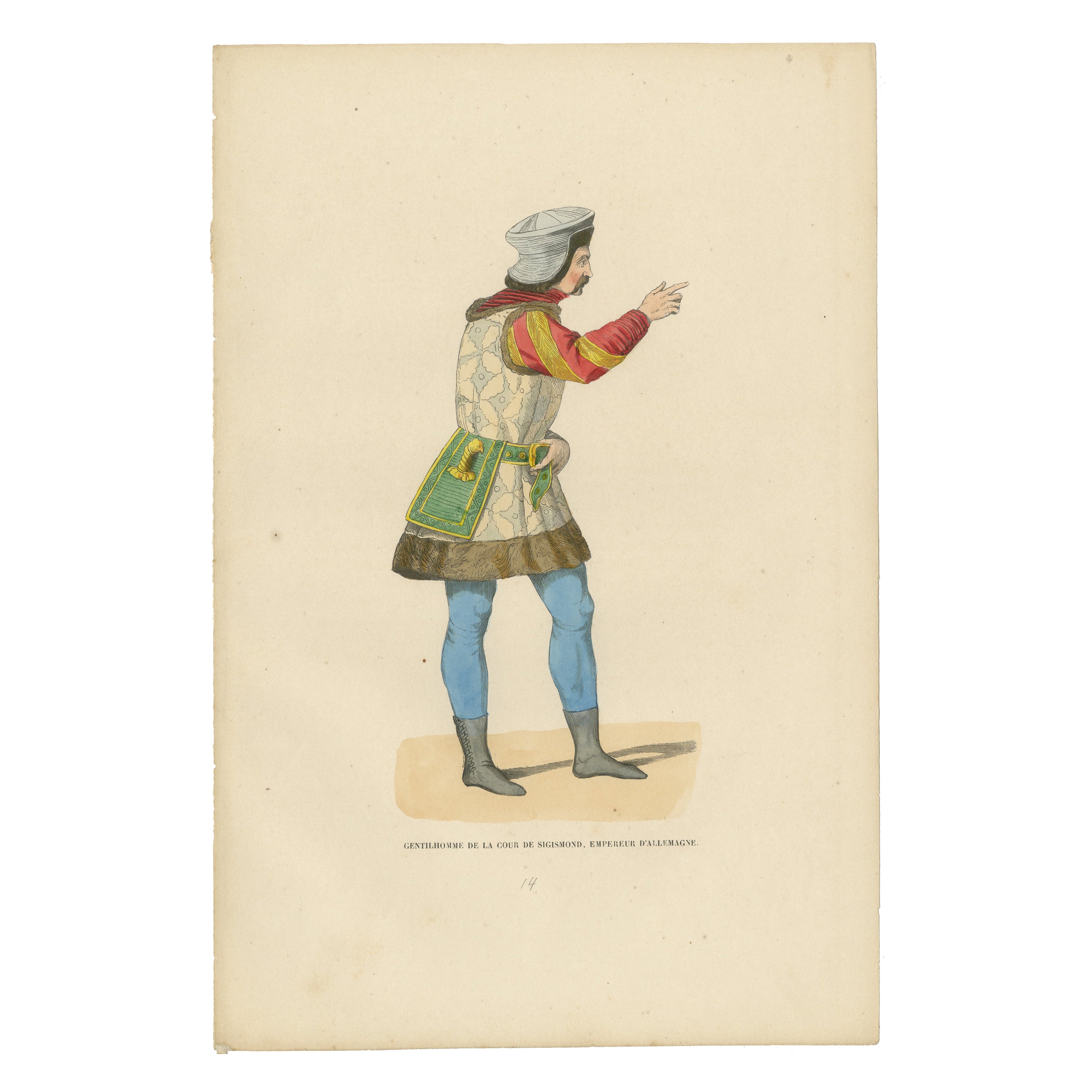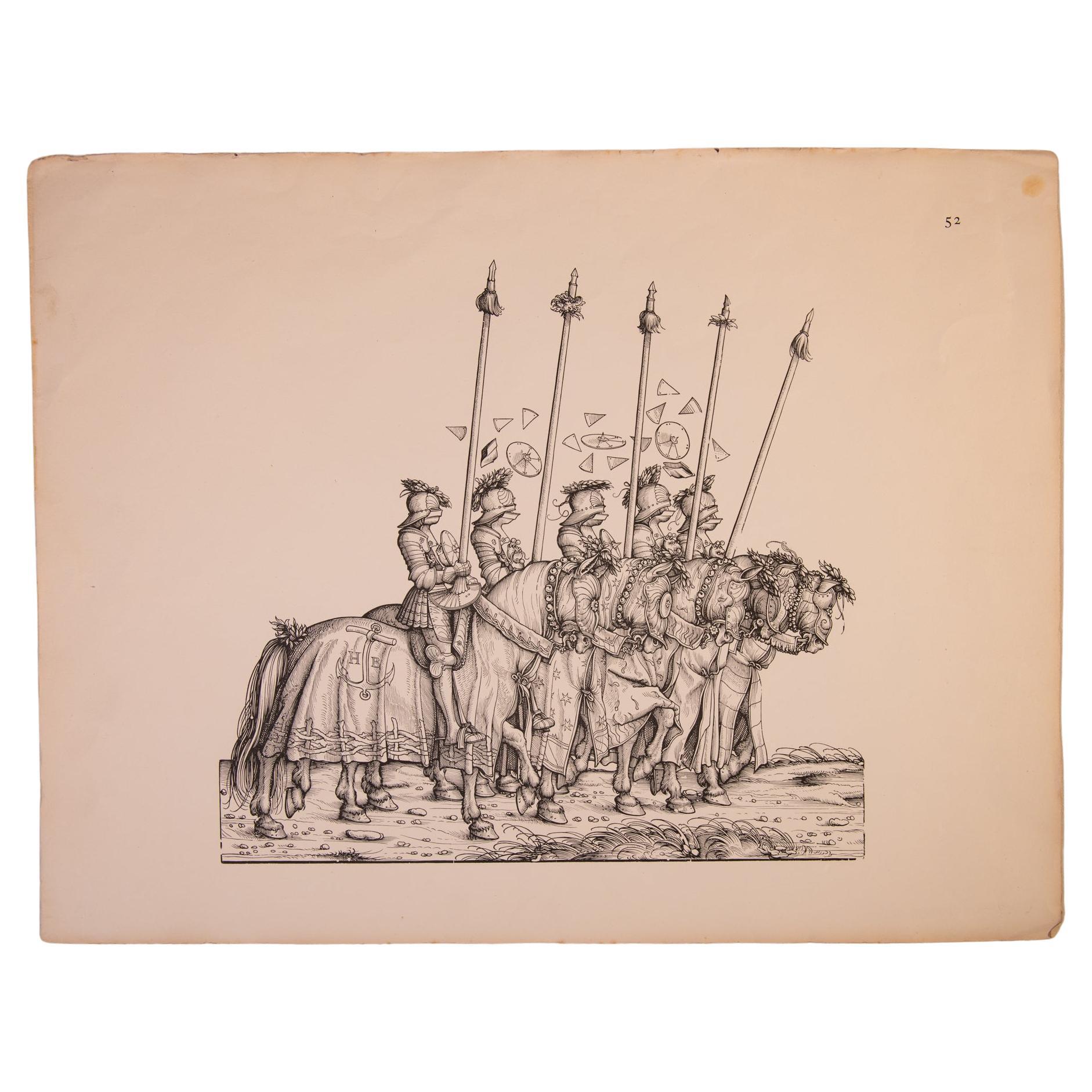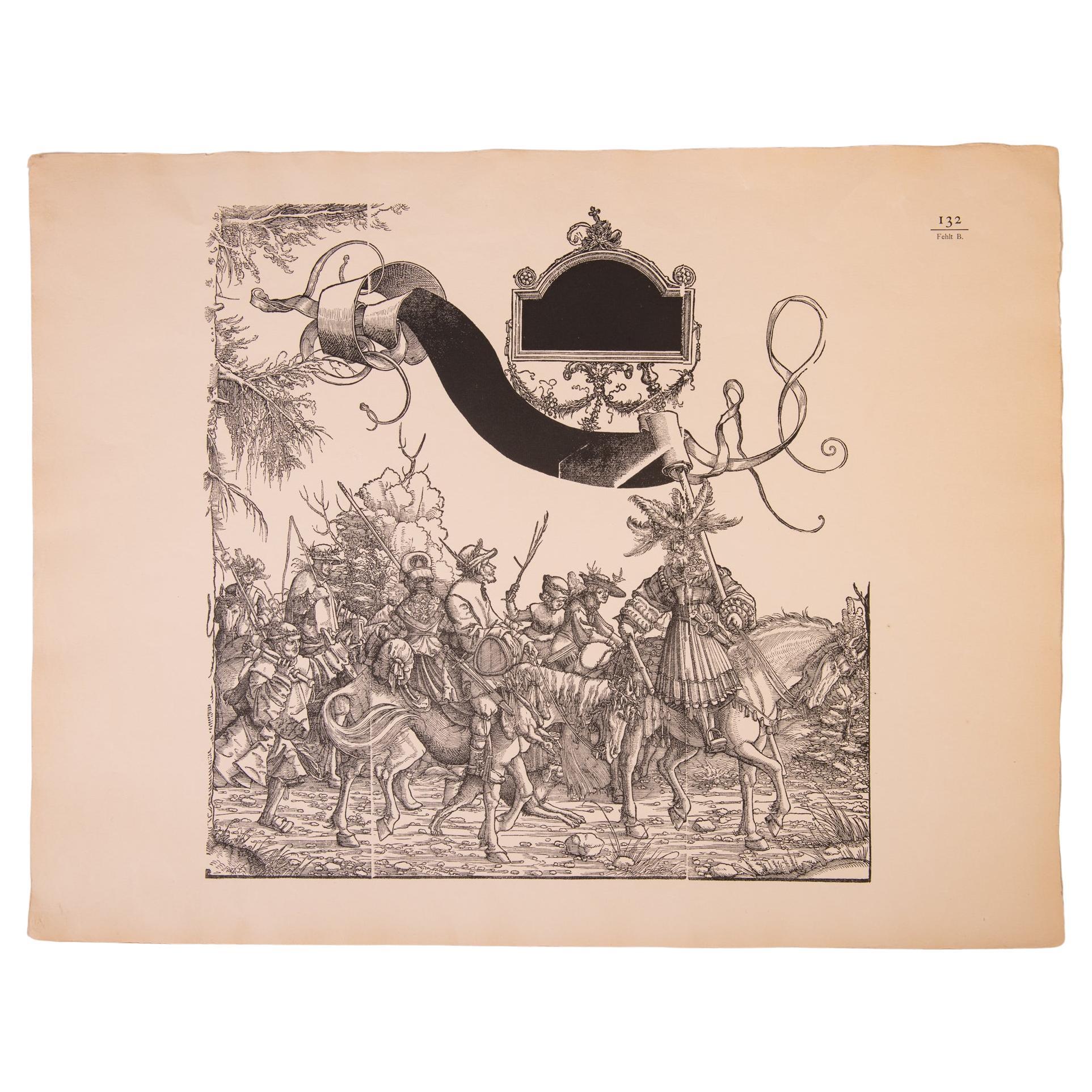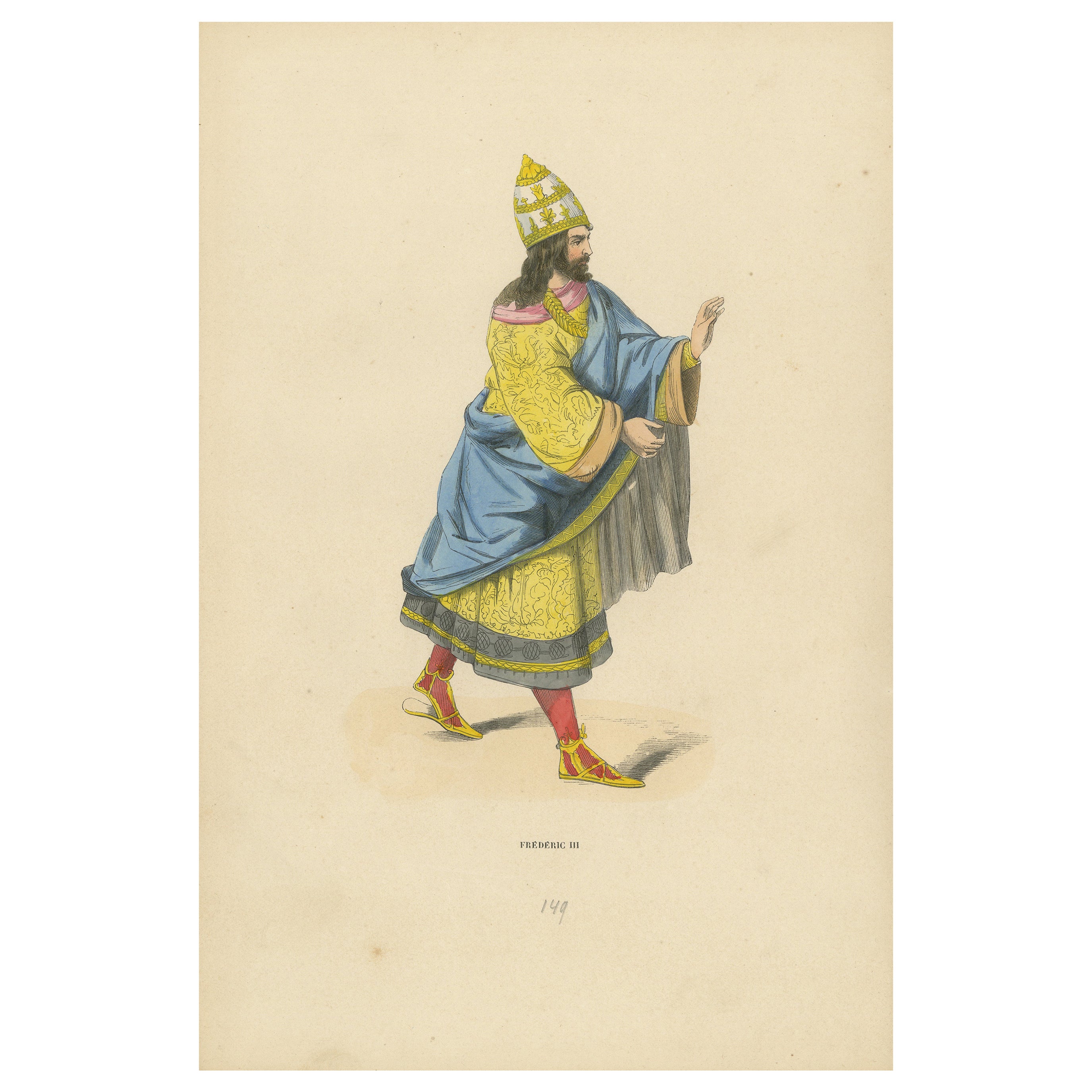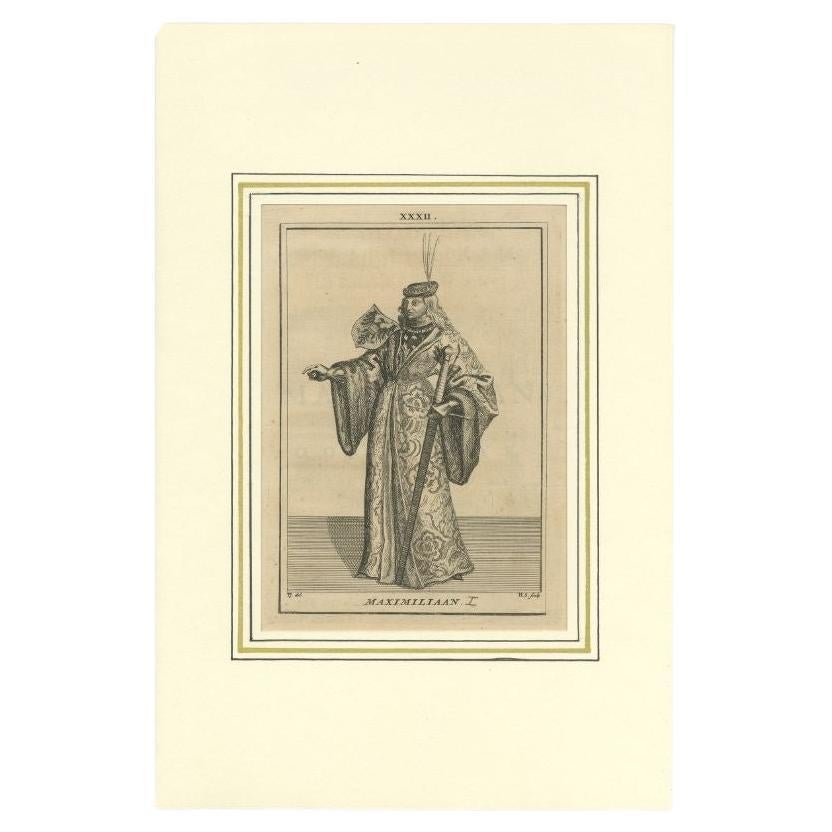Items Similar to Imperial Splendor: Emperor Maximilian on Parade, 1847
Want more images or videos?
Request additional images or videos from the seller
1 of 7
Imperial Splendor: Emperor Maximilian on Parade, 1847
About the Item
Title: "Regal Bearing: Emperor Maximilian on Parade"
Description: This historical illustration depicts Emperor Maximilian arrayed in full regalia, mounted on a proud and well-groomed steed. Maximilian, known for his pivotal role in European history, sits with an air of composed authority, reflecting his status as a ruler and a commander.
The Emperor's armor is detailed and functional, highlighted with elements that signify his imperial status. His helmet is adorned with a distinctive plume, signaling his high rank and adding to the pageantry of his appearance. The horse's caparison is resplendent, emblazoned with the heraldic colors and symbols associated with the Emperor, indicating his royal lineage and the vast territories under his reign.
Maximilian's posture, upright and confident, along with his hand resting on the pommel of his sword, is emblematic of his readiness to lead and defend his empire. The overall composition of the illustration, from the Emperor's regal attire to the horse's elaborate trappings, is a powerful representation of the majesty and the ceremonial splendor that surrounded the European nobility and their courts during the Renaissance. It's a window into the past, capturing the essence of the imperial power and the grandeur of the era.
The colors have a nice glow over them. Historically, egg whites, known as glair, and sometimes egg yolk were indeed used in illumination and painting, particularly in manuscripts, to give colors a brighter appearance and to add a sheen or gloss to the work. This technique was quite common during the Middle Ages and into the Renaissance.
Egg whites can be applied as a varnish over pigments to enhance their brightness and to protect the colors. This application could make the colors appear more vivid and also add a slight glossy sheen to the surface of the image.
Egg yolk, on the other hand, was commonly used as a binding agent in paint. It forms the basis of tempera paint, a medium that was widely used before the advent of oil painting. Egg yolk helps to create a durable and long-lasting color that adheres well to various surfaces.
In the context of the print from 1847, it's less likely that egg whites or yolks were used directly on the print, as by that time, commercial printing processes would have been more advanced and less reliant on such manual methods. However, if this print is a representation of an earlier style or is meant to mimic the appearance of hand-painted manuscripts, the original artists might have employed techniques or materials that gave a similar effect to those achieved with egg-based binders and varnishes.
- Dimensions:Height: 7.09 in (18 cm)Width: 10.63 in (27 cm)Depth: 0 in (0.02 mm)
- Materials and Techniques:
- Period:
- Date of Manufacture:1847
- Condition:Good. Overal light toning and light soiling but the image itself clean and hand-colored almost 200 years ago and still in expliciet colors. Aged paper with typically warm, yellowish-brown hue, mostly around the edges. Study the images carefully.
- Seller Location:Langweer, NL
- Reference Number:
About the Seller
5.0
Platinum Seller
These expertly vetted sellers are 1stDibs' most experienced sellers and are rated highest by our customers.
Established in 2009
1stDibs seller since 2017
1,919 sales on 1stDibs
Typical response time: <1 hour
- ShippingRetrieving quote...Ships From: Langweer, Netherlands
- Return PolicyA return for this item may be initiated within 14 days of delivery.
More From This SellerView All
- Courtly Splendor: A Nobleman at Emperor Sigismund's Court, 1847Located in Langweer, NLThe image depicts a man identified as a "Gentilhomme de la cour de Sigismond, empereur d'Allemagne," which translates to "Gentleman of the court of Sigismund, Emperor of Germany." This individual is portrayed in a profile stance, dressed in attire that is indicative of the high-status courtiers during the time of Emperor Sigismund, who reigned in the early 15th century. He is wearing a turban-like headgear, which reflects the influence of Eastern fashion on European court attire, possibly due to the Ottoman influence or the general exchange of culture during the Crusades and subsequent interactions. His doublet is richly patterned and he has puffed sleeves in red, which were fashionable among the nobility during the period. The garment is accented with a decorative belt that holds what appears to be a purse or a pouch. He also sports tight blue hose and pointed shoes, which complete the ensemble typical of a nobleman or a high-ranking court official in the Holy Roman Empire. Egg whites can be applied as a varnish over pigments to enhance their brightness and to protect the colors. This application could make the colors appear more vivid and also add a slight glossy sheen to the surface of the image. Egg yolk, on the other hand, was commonly used as a binding agent in paint. It forms the basis of tempera paint, a medium that was widely used before the advent of oil painting. Egg yolk helps to create a durable and long-lasting color that adheres well to various surfaces. In the context of the print from 1847, it's less likely that egg whites or yolks were used directly on the print, as by that time, commercial printing processes would have been more advanced and less reliant on such manual methods. However, if this print is a representation of an earlier style or is meant to mimic the appearance of hand-painted manuscripts...Category
Antique 1840s Prints
MaterialsPaper
- Imperial Majesty: Emperor Frederick III in 'Costume du Moyen Âge, 1847Located in Langweer, NLTitle: "Imperial Majesty: Emperor Frederick III in 'Costume du Moyen Âge'" Description: This lithograph from the "Costume du Moyen Âge" collection, printed in 1847, depicts Emperor ...Category
Antique 1840s Prints
MaterialsPaper
- Antique Print of Maximilian I, Holy Roman Emperor, 1745Located in Langweer, NLAntique print titled 'Maximiliaan'. Original print of Maximilian I. This print originates from 'De Graaven van Holland' by Pieter Langendijk. Published by...Category
Antique 18th Century Prints
MaterialsPaper
- Ecclesiastical Splendor: The Archbishop's Regalia in a Lithograph of 1847Located in Langweer, NLTitle: "Ecclesiastical Splendor: The Archbishop's Regalia in 'Costume du Moyen Âge'" Description: This historically rich lithograph from the 1847 edition of "Costume du Moyen Âge" d...Category
Antique 1840s Prints
MaterialsPaper
- Standard-Bearer of Venice: Military Splendor of the Renaissance, 1847Located in Langweer, NLThis is an illustration of a soldier from Venice, known as a "Soldat Vénitien." The image is likely from a historical or military costume book, detailing the dress and equipment of v...Category
Antique 1840s Prints
MaterialsPaper
- Imperial Dignity: A Roman Senator's Garb, Lithograph Published in 1847Located in Langweer, NLTitle: "Imperial Dignity: A Roman Senator's Garb in 'Costume du Moyen Âge'" Description: This lithograph, part of the 1847 "Costume du Moyen Âge" collection, depicts a Roman senator...Category
Antique 1840s Prints
MaterialsPaper
You May Also Like
- Engraving of Maximilian I° Roman Emperor "Knights in a Parade"Located in Alessandria, PiemonteST/728-2. Engraving of Maximilian I°, Roman emperor, from the original engravings "The triumph of Maximilian " of the 16th and 17th centuries by Albrecht Altdorfer (Landshut 1480- R...Category
Early 20th Century European Other Prints
MaterialsPaper
- Engraving of Maximilian I° Roman EmperorLocated in Alessandria, PiemonteST/728-1 . Engraving of Maximilian I°, beginning 1930, from the original engravings of the 16th and 17th centuries. "Mounted knights in armour in a procession " by Albrecht Altdorfe...Category
Mid-20th Century Other Prints
MaterialsPaper
- Engraving of Maximilian I° Roman EmperorLocated in Alessandria, PiemonteST/728 /3 - Engraving of Maximilian I° - Procession (noy better specified) - from the original engravings of the 16th and 17th centuries by Albrecht Altdorfer - Germany (Landshut 1...Category
Mid-20th Century Other Prints
MaterialsPaper
- 1515 Albrecht Durer Emperor Maximilian & Mary, Woodcut, Triumphal ArchBy Albrecht DürerLocated in Norwich, GBThe Betrothal of Mary of Burgundy from the Triumphal Arch of Emperor Maximilian I Emperor Maximilian and Mary Im Krieg so Er im Geldern führt , Dabey Mann noch fein Mammheit spürt Manchritterliches Blut vergoßz / Wie wols sein Wiederthcyl verdroß / Doch macht Er sie ... 231mm × w 151mm Bartsch 138; Meder 251; The Metropolitan Museum of Art dates this woodcut to 1515. Production of the Arch of Honor was essentially completed by 1515 but was delayed in release while Maximilian ordered his court historians to add further research into his purported early ancestry. Only a small number of proofs were completed before the emperor’s death, so most of the early printings of complete sets of the Arch were only made and distributed by his grandson Ferdinand I in 1526. Another edition appeared from the Habsburgs in 1559. Woodcut by Albrecht Durer...Category
Antique 16th Century German Renaissance Prints
MaterialsPaper
- Aquatic Splendor, Framed & Signed Art Print by Brent HeightonLocated in Delray Beach, FLBrent Heighton has been painting for over 42 years full time. After college Brent began a brief career in the commercial art field. Not satisfied with the deadlines, the rush jobs, a...Category
Vintage 1980s American Prints
MaterialsWood
- Su Xiaobai "Imperial Academy 1", 2018By Su XiaobaiLocated in Barcelona, BarcelonaSu Xiaobai "Imperial Academy 1" Etching, aquatint, carborundum and collagraph, 2018 Edition 40 Measures: 64 x 59.5 cm. Number of Edition might be different as we have more ...Category
2010s Chinese Modern Prints
MaterialsPaper
